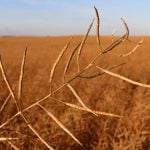Molecular signals | Understanding how plants grow will help improve production and preserve diversity
LINDELL BEACH, B.C. — Leaves come in all shapes and sizes.
But why is that, and how do they form?
How do they turn from a tiny bud of a few cells to the individual complex shapes of each plant species?
Scientists at the John Innes Centre (JIC) in Norwich, U.K., have discovered simple rules that control leaf shape during growth.
Using these rules, they have developed the first computational model to accurately emulate leaf growth from a bud in virtual form.
Read Also

Manitoba pork exports gain new market ground
Manitoba’s pork trade pivoted from China over the last five years, while Japan is remains the largest customer and South Korea and Mexico market footholds have grown
“A bud does not grow in all directions at the same rate,” said Sam-antha Fox, a plant researcher with the JIC and lead author of the report, Generation of Leaf Shape through Early Patterns of Growth and Tissue Polarity, published in the journal Science.
“Otherwise, leaves would be domed like a bud, not flat with a pointed tip.”
To find out how plant growth works, Fox said researchers developed a process using computer modelling to recreate a virtual growing leaf.
A novel kind of imaging helped them visualize the cells dividing and expanding, and a mathematical model simulated growing the leaf in an attempt to understand the procedure.
The plant they used in their study was arabidopsis, a relative of rapeseed.
First, they filmed a growing leaf to help create the model that would simulate the growing process. Then they filmed the actual cells and tracked each one as the plant grew. The researchers needed to check the workings behind the visual changes and test them in normal and mutant plants.
They grew seedlings under the microscope and filmed every stage of growth to capture cell divisions and expansions as they actually happened.
By analyzing the imaging data, they made many measurements of the leaf as it grew over time and then used computational modelling to understand its growth stages.
This is not the same as animating the growth of a leaf. Fox said in a video prepared by the JIC that it is much more difficult to make a leaf grow dynamically from a bud and realistically recreate the shape of the leaf as it is seen biologically.
By studying the images, they have amassed a wealth of information to help them understand the rules behind making a leaf.
“The model is not just based on drawings of leaf shapes at different stages,” said professor Enrico Coen, corresponding author.
“To accurately recreate dynamic growth from bud to leaf, we had to establish the mathematical rules governing how leaf shapes are formed.”
With that information programmed into the model, it could run independently to build a virtual but realistic leaf.
Fox said that despite the wide variety of leaf shapes, there are not a lot of complicated ways in which the leaves form.
Researchers discovered that plants have an inbuilt system for detecting orientation, rather like an inbuilt compass.
Instead of using a magnetic field, they have a molecular pattern that they produce themselves with reference points such as the base and the tip, rather than north and south on a compass.
These molecular signals guide the axis on which they grow, and the orientation and axis changes as plant tissues deform during growth.
The molecular signals become patterned from an early stage within the bud, helping the leaf shape emerge.
“This molecular pattern is fixed at a really early stage of development,” said Fox.
“Once we realized that, it was possible to generate lots of different shapes, based on a simple system.”
Researchers marked spots on the small bud to follow the growth, and as it grew they were able to see where the growth originated.
They discovered that the molecular pattern is already present when a bud starts to divide and turn into a new leaf.
Part of this pattern is to transform the dome-shaped bud into a flattened leaf.
However, if this dome shape were to grow equally in all directions, the end result would be a large domed appendage.
The molecular patterning governs most of the growth coming from the base of the tiny bud and early leaf.
The computational model can now be used to help identify the genes that control leaf shape and whether different genes are behind different shapes.
The research is a major breakthrough in the understanding of how plants grow, which will help improve food and fuel production and preserve diversity.
The goal now is to extend the models to include more virtual complex leaves such as maples with their finger-shaped leaves.
“This exciting research highlights the potential of using computer and mathematical models for biological research to help us tackle complex questions and make predictions for the future,” said professor Douglas Kell, chief executive officer of the funding agency Biotechnology and Biological Sciences Research Council.
“Computational modelling can give us a deeper and more rapid understanding of the biological systems that are vital to life on Earth.”














